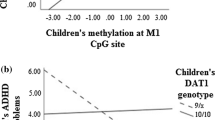Abstract
Recent evidence suggests that epigenetic regulation of the DRD4 gene may characterise specific aspects of ADHD symptomology. We tested associations between ADHD symptoms and epigenetic changes to the DRD4 gene in DNA extracted from blood and saliva in N = 330 children referred for a variety of behavioural and emotional problems. ADHD was indexed using DSM diagnoses as well as mother, father, and teacher reports. Methylation levels were assayed for the island of 18 CpG sites in the DRD4 receptor gene. A nearby SNP, rs3758653, was also genotyped as it has previously been shown to influence methylation levels. There was high consistency of methylation levels across CpG sites and tissue sources, and higher methylation levels were associated with the major allele of SNP rs3758653. Higher methylation levels were associated with more severe ADHD independent of SNP status, tissue source, ethnicity, environmental adversity, and comorbid conduct problems. The association applied specifically to the cognitive/attentional, rather than hyperactivity problems that characterise ADHD. The results indicate that epigenetic regulation of the DRD4 gene in the form of increased methylation is associated with the cognitive/attentional deficits in ADHD.

Similar content being viewed by others
References
Meaney MJ, Szyf M (2005) Environmental programming of stress responses through DNA methylation: life at the interface between a dynamic environment and a fixed genome. Dialogues Clin Neurosci 7(2):103–123
Szyf M (2013) The genome- and system-wide response of DNA methylation to early life adversity and its implication on mental health. Can J Psychiatry 58(12):697–704
Szyf M, Bick J (2013) DNA methylation: a mechanism for embedding early life experiences in the genome. Child Dev 84(1):49–57
Oak JN, Oldenhof J, Van Tol HHM (2000) The dopamine D4 receptor: one decade of research. Eur J Pharmacol 405(1–3):303–327
Hawi Z et al (2015) The molecular genetic architecture of attention deficit hyperactivity disorder. Mol Psychiatry 20(3):289–297
van Mil NH et al (2014) DNA methylation profiles at birth and child ADHD symptoms. J Psychiatr Res 49(1):51–59
Xu Y et al (2015) Multiple epigenetic factors predict the attention deficit/hyperactivity disorder among the Chinese Han children. J Psychiatr Res 64:40–50
Cheng J et al (2014) Male-specific association between dopamine receptor D4 gene methylation and schizophrenia. PLoS One 9(2):e89128
Docherty, S.J., et al. A genetic association study of DNA methylation levels in the DRD4 gene region finds associations with nearby SNPs. Behav Brain Funct, 2012. 8
Wong CCY et al (2010) A longitudinal study of epigenetic variation in twins. Epigenetics 5(6):516–526
Fusar-Poli P et al (2012) Striatal dopamine transporter alterations in ADHD: pathophysiology or adaptation to psychostimulants? A meta-analysis. Am J Psychiatry 169(3):264–272
APA, Diagnostic and statistical manual of mental disorders : DSM-IV, ed. A. American Psychiatric and D.-I. American Psychiatric Association. Task Force on. 1994, Washington, DC: American Psychiatric Association
Johnson S et al (1999) The diagnostic interview schedule for children, adolescents, and parents: initial reliability and validity data. Behav Change 16(3):155–164
Conners, C.K., Conners’ Rating Scales—Revised, 1997
Rey JM et al (1997) A global scale to measure the quality of the family environment. Arch Gen Psychiatry 54(9):817–822
Australian Bureau of Statistics (2006) Socio-economic indexes for areas. Retrieved from http://www.abs.gov.au
O’Connor BP (2000) SPSS and SAS programs for determining the number of components using parallel analysis and Velicer’s MAP test. Behav Res Methods Instrum Comput 32(3):396–399
O’Connor BP (1998) Simple: all-in-one programs for exploring interactions in moderated multiple regression. Educ Psychol Measur 58(5):836–840
Gottesman II, Gould TD (2003) The endophenotype concept in psychiatry: etymology and strategic intentions. Am J Psychiatry 160(4):636–645
Acknowledgments
This research was supported in part by Grants from the National Health and Medical Research Council of Australia and the Australia Research Council. We are grateful to Royal Far West for support of the research, Australian Genome Research Facility for genetic assays, and to all the families and children who participated.
Author information
Authors and Affiliations
Corresponding author
Ethics declarations
Conflict of interest
The authors declare that they have no conflict of interest.
Ethical standards
The research was approved by the UNSW ethics committee and have therefore been performed in accordance with the ethical standards laid down in the 1964 Declaration of Helsinki and its later amendments. All persons gave their informed consent prior to their inclusion in the study.
Electronic supplementary material
Below is the link to the electronic supplementary material.
Rights and permissions
About this article
Cite this article
Dadds, M.R., Schollar-Root, O., Lenroot, R. et al. Epigenetic regulation of the DRD4 gene and dimensions of attention-deficit/hyperactivity disorder in children. Eur Child Adolesc Psychiatry 25, 1081–1089 (2016). https://doi.org/10.1007/s00787-016-0828-3
Received:
Accepted:
Published:
Issue Date:
DOI: https://doi.org/10.1007/s00787-016-0828-3




